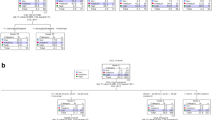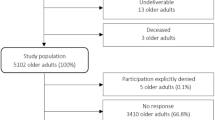Abstract
The purpose of the present study was to identify health and well-being typologies among a sample of older European adults. Further, we examined various demographic, social, and health behaviour characteristics that were used to discriminate between such groups. The participants were 1,381 community-dwelling adults aged 65 years and above (M age = 73.65; SD = 7.77) from six European Union (EU) countries who completed self-reported questionnaires. Hierarchical cluster analysis was initially conducted followed by a k means analysis to confirm cluster membership. Four clusters were identified and validated: ‘good health and moderate functioning’ (38.40%), ‘moderate health and functioning’ (30.84%), ‘obese and depressed’ (20.24%) and ‘low health and functioning’ (10.51%). The groups could be discriminated based on age, gender, nationality, years of education, social isolation and health behaviours (alcohol consumption and walking behaviour). The results of the study demonstrate heterogeneity with regard to the relationships between the variables examined. The information can be used in targeting older Europeans for health promotion interventions.

Similar content being viewed by others
References
Aldenderfer MS, Blashfield RK (1984) Cluster analysis. Sage Publications, Beverly Hills, CA
Balfour JL, Kaplan GA (2002) Neighborhood environment and loss of physical function in older adults: evidence from the Alameda County study. Am J Epidemiol 155:507–515
Beekman ATF, Deeg DJH, van Limbeek J, Braam AW, de Vries MZ, van Tilburg W (1997) Criterion validity of the Center for Epidemiologic Studies Depression Scale (CES-D): results from a community-based sample of older adults in the Netherlands. Psychol Med 27:231–235
Berkman LF (1995) The role of social relations in health promotion. Psychosom Med 57:245–254
Borglin G, Jakobsson U, Edberg A-K, Rahm Hallberg I (2006) Older people in Sweden with various degrees of present quality of life: their health, social support, everyday activities and sense of coherence. Health Soc Care Community 14:136–146
Börsch-Supan A, Brugiavini A, Jürges H, Machenbach J, Siegrist J, Weber G (2005a) Health, ageing and retirement in Europe: first results from the survey of health, ageing and retirement in Europe. Mannheim Research Institute for the Economics of Ageing, Mannheim
Börsch-Supan A, Hank K, Jürges H (2005b) A new comprehensive and international view on ageing: introducing the survey of health, ageing and retirement in Europe. Eur J Ageing 2:245–253
Bowling A (1995) What things are important in people’s lives? A survey of the public’s judgements to inform scales of health related quality of life. Soc Sci Med 41:1447–1462
Byrne BM (1996) Measuring self-concept across the life span: issues and instrumentation. American Psychological Association, Washington, DC
Chou KL (2007) Reciprocal relationship between pain and depression in older adults: evidence from the English Longitudinal Study of Ageing. J Affect Disord 102:115–123
Chou KL (2008) The prevalence and clustering of four major lifestyle risk factors in Hong Kong Chinese older adults. J Aging Health 20:788–803
Conn VS, Taylor SG, Hayes V (1992) Social support, self-esteem, and self-care after myocardial infarction. Health Value 16:25–31
Craig CL, Marshall AL, Sjostrom M, Bauman AE, Booth ML, Ainsworth BE, Pratt M, Ekelund U, Yngve A, Sallis JF, Pekka O (2003) International physical activity questionnaire: 12-country reliability and validity. Med Sci Sports Exerc 35:1381–1395
De Leo D, Diekstra RF, Lonnqvist J, Cleiren HPD, Frisoni GB, Dello Buono M, Haltunen A, Zucchetto M, Rozzini R, Grigoletto F, Sampaio-Faria J (1998) LEIPAD, an internationally applicable instrument to assess quality of life in the elderly. Behav Med 24:17–27
Deng HB, MacFarlane DJ, Thomas GN, Lao XQ, Jiang CQ, Cheng KK, Lam TH (2008) Reliability and validity of the IPAQ-Chinese: the Guangzhou Biobank Cohort Study. Med Sci Sports Exerc 40:303–307
Diehl M, Hastings CT, Stanton JM (2001) Self-concept differentiation across the adult life span. Psychol Aging 16:643–654
Diener E, Emmons RA, Larsen RJ, Griffin S (1985) The satisfaction with life scale. J Pers Assess 49:71–75
Fontaine KR, Barofsky I (2001) Obesity and health-related quality of life. Obes Rev 2:173–182
Friedman JM, Elasy T, Jensen GL (2001) The relationship between body mass index and self-reported functional limitation among older adults: a gender difference. J Am Geriatr Soc 49:398–403
García EL, Banegas JR, Pérez-Regadera AG, Herruzo Cabrera R, Rodriquez-Artalejo F (2005) Social network and health-related quality of life in older adults: a population-based study in Spain. Qual Life Res 14:511–520
Gayman MD, Turner RJ, Cui M (2008) Physical limitations and depressive symptoms: exploring the nature of the association. J Gerontol Soc Sci 63B:S219–S228
Gerstorf D, Smith J, Baltes PB (2006) A systemic-wholistic approach to differential aging: longitudinal findings from the Berlin Aging Study. Psychol Aging 21:645–663
Hair JF, Anderson RE, Tatham RL, Black WC (1998) Multivariate data analysis, 5th edn. Prentice Hall, Upper Saddle River, NJ
Haveman-Nies A, de Groot L, van Staveren WA (2003) Relation of dietary quality, physical activity, and smoking habits to 10-year changes in health status in older Europeans in the SENECA study. Am J Public Health 93:318–323
Heslin JM, Soveri PJ, Winoy JB, Lyons RA, Buttanshaw AC, Kovacic L, Daley JA, Gonzalo E (2001) Health status and service utilisation of older people in different European countries. Scand J Prim Health 19:218–222
Italian National Institute of Statistics (2001) Data available from http://dawinci.istat.it/MD/
Kolbe-Alexander TL, Lambert EV, Harkins JB, Ekelund U (2006) Comparison of two methods of measuring physical activity in South African older adults. J Aging Phys Act 14:98–114
Koster A, Bosma H, Kempen GIJM, Penninx BWJH, Beekman ATF, Deeg DJH, van Eijk JTM (2006) Socioeconomic differences in incident depression in older adults: the role of psychosocial factors, physical health status, and behavioral factors. J Psychosom Res 61:619–627
Lang I, Wallace RB, Huppert FA, Melzer D (2007) Moderate alcohol consumption in older adults is associated with better cognition and well-being than abstinence. Age Ageing 36:256–261
Marsh HW (1996) Positive and negative global self-esteem: a substantively meaningful distinction or artifactors? J Pers Soc Psychol 70:810–819
McAuley E, Elavsky S, Motl RW, Konopack JF, Hu L, Marquez DX (2005) Physical activity, self-efficacy, and self-esteem: longitudinal relationships in older adults. J Gerontol Psychol Sci 60B:P268–P275
Minicuci N, Maggi S, Pavan M, Enzi G, Crepaldi G (2002) Prevalence rate and correlates of depressive symptoms in older individuals: the Veneto study. J Gerontol Med Sci 57A:M155–M161
Mroczek DK, Spiro A (2005) Change in life satisfaction during adulthood: findings from the Veterans Affairs Normative Aging Study. J Pers Soc Psychol 88:189–202
Murrell SA, Meeks S, Walker J (1991) Protective functions of health and self-esteem against depression in older adults facing illness or bereavement. Psychol Aging 5:352–360
Nagi SZ (1976) An epidemiology of disability among adults in the United States. Milbank Meml Fund Q Health Soc 54:439–467
Penninx BWJH, Guralnik JM, Ferrucci L, Simonsick EM, Deeg DJH, Wallace RB (1998) Depressive symptoms and physical decline in community-dwelling older persons. JAMA 279:1720–1726
Pinquart M (2001) Correlates of subjective health in older adults: a meta-analysis. Psychol Aging 16:414–426
Põlluste K, Kalda R, Lember M (2009) Accessibility and use of health services among older Estonian population. Cent Eur J Public Health 17:64–70
Radloff LS (1977) The CES-D scale. Appl Psychol Meas 1:385–401
Rosenberg M (1979) Conceiving the self. Basic Books, New York
Seeman TE, Syme SL (1987) Social networks and coronary heart disease: a comparison of the structure and function of social relations as predictors of disease. Psychosom Med 49:341–354
Smith J, Baltes PB (1997) Profiles of psychological functioning in the old and oldest old. Psychol Aging 12:458–472
Smith J, Baltes MM (1998) The role of gender in very old age: profiles of functioning and everyday life patterns. Psychol Aging 13:676–695
Smits MW, Kee CC (1992) Correlates of self-care among the independent elderly: self-concept affects well-being. J Gerontol Nurs 18:13–18
Statistics Finland (2009) Data available from: http://www.tilastokeskus.fi/org/index_en.html
Strawbridge WJ, Cohen RD, Shema SJ, Kaplan GA (1996) Successful aging: predictors and associated activities. Am J Epidemiol 144:135–141
Thøgersen-Ntoumani C, Ntoumanis N, Nikitaras N (2008) Typologies of Greek inactive older adults based on reasons for abstaining from exercise and conditions for change. J Sport Sci 26:1341–1350
Turner Goins R, Spencer SM, Krummel DA (2003) Effect of obesity on health-related quality of life among Appalachian elderly. Southern Med J 96:552–557
Van den Brink CL, Vanden Bos GAM, Tijhuis M, Äijänseppä S, Nissinen A, Giampaoli S, Kromhout D (2006) Hierarchy levels, sum score, and worsening of disability are related to depressive symptoms in elderly men from three European countries. J Aging Health 18:125–141
Victor CR, Scambler SJ, Bowling A, Bond J (2005) The prevalence of, and risk factors for, loneliness in later life: a survey of older people in Great Britain. Ageing Soc 25:357–375
Weiss MR, Ebbeck V, Horn TS (1997) Children’s self-perceptions and sources of physical competence information: a cluster analysis. J Sport Exerc Psychol 19:52–70
Yan LL, Daviglus ML, Liu K, Pirzada A, Garside DB, Schiffer L, Dyer AR, Greenland P (2004) BMI and health-related quality of life in adults 65 years and older. Obes Res 12:69–76
Yusef S, Hawken S, Ounpuu S, Dans T, Avezum A, Lanas F, McQueen M, Budaj A, Pais P, Varigos J, Lisheng L, and on behalf of the INTERHEART Study Investigators (2004) Effect of potentially modifiable risk factors associated with myocardial infarction in 52 countries (the INTERHEART study): case–control study. Lancet 364:937–952
Zimmer Z, House JS (2003) Education, income, and functional limitation transitions among American adults: contrasting onset and progression. Int J Epidemiol 32:1089–1097
Zunzunegui MV, Minicuci N, Blumstein T, Noale M, Deeg D, Jylhä M, Pedersen ML, and for the CLESA Working Group (2007). Gender differences in depressive symptoms among older adults: a cross-national comparison. Soc Psychiatry Psychiatr Epidemiol 42:198–207
Author information
Authors and Affiliations
Corresponding author
Additional information
Responsible editor: D.J.H. Deeg
Rights and permissions
About this article
Cite this article
Thøgersen-Ntoumani, C., Barkoukis, V., Grano, C. et al. Health and well-being profiles of older European adults. Eur J Ageing 8, 75–85 (2011). https://doi.org/10.1007/s10433-011-0186-4
Published:
Issue Date:
DOI: https://doi.org/10.1007/s10433-011-0186-4




